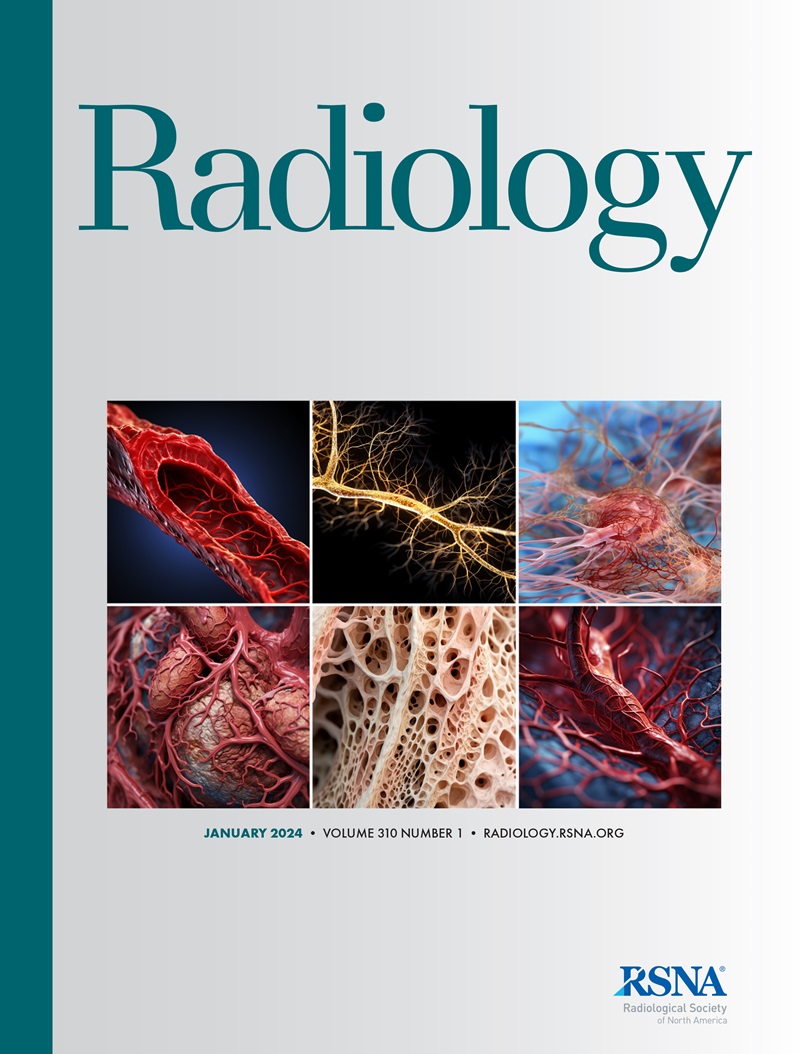Bastiaan M Privé, Bas Israël, Marcel J R Janssen, Marloes M G van der Leest, Maarten de Rooij, Jolique A van Ipenburg, Marianne Jonker, Steffie M B Peters, Michel de Groot, Patrik Zámecnik, Alexander Hoepping, Joyce G Bomers, Martin Gotthardt, J P Michiel Sedelaar, Jelle O Barentsz, Inge M van Oort, James Nagarajah
求助PDF
{"title":"多参数磁共振成像和 18F-PSMA-1007 PET/CT 用于检测具有临床意义的前列腺癌。","authors":"Bastiaan M Privé, Bas Israël, Marcel J R Janssen, Marloes M G van der Leest, Maarten de Rooij, Jolique A van Ipenburg, Marianne Jonker, Steffie M B Peters, Michel de Groot, Patrik Zámecnik, Alexander Hoepping, Joyce G Bomers, Martin Gotthardt, J P Michiel Sedelaar, Jelle O Barentsz, Inge M van Oort, James Nagarajah","doi":"10.1148/radiol.231879","DOIUrl":null,"url":null,"abstract":"<p><p>Background Multiparametric MRI (mpMRI) is effective for detecting prostate cancer (PCa); however, there is a high rate of equivocal Prostate Imaging Reporting and Data System (PI-RADS) 3 lesions and false-positive findings. Purpose To investigate whether fluorine 18 (<sup>18</sup>F) prostate-specific membrane antigen (PSMA) 1007 PET/CT after mpMRI can help detect localized clinically significant PCa (csPCa), particularly for equivocal PI-RADS 3 lesions. Materials and Methods This prospective study included participants with elevated prostate-specific antigen (PSA) levels referred for prostate mpMRI between September 2020 and February 2022. <sup>18</sup>F-PSMA-1007 PET/CT was performed within 30 days of mpMRI and before biopsy. PI-RADS category and level of suspicion (LOS) were assessed. PI-RADS 3 or higher lesions at mpMRI and/or LOS 3 or higher lesions at <sup>18</sup>F-PSMA-1007 PET/CT underwent targeted biopsies. PI-RADS 2 or lower and LOS 2 or lower lesions were considered nonsuspicious and were monitored during a 1-year follow-up by means of PSA testing. Diagnostic accuracy was assessed, with histologic examination serving as the reference standard. International Society of Urological Pathology (ISUP) grade 2 or higher was considered csPCa. Results Seventy-five participants (median age, 67 years [range, 52-77 years]) were assessed, with PI-RADS 1 or 2, PI-RADS 3, and PI-RADS 4 or 5 groups each including 25 participants. A total of 102 lesions were identified, of which 80 were PI-RADS 3 or higher and/or LOS 3 or higher and therefore underwent targeted biopsy. The per-participant sensitivity for the detection of csPCa was 95% and 91% for mpMRI and <sup>18</sup>F-PSMA-1007 PET/CT, respectively, with respective specificities of 45% and 62%. <sup>18</sup>F-PSMA-1007 PET/CT was used to correctly differentiate 17 of 26 PI-RADS 3 lesions (65%), with a negative and positive predictive value of 93% and 27%, respectively, for ruling out or detecting csPCa. One additional significant and one insignificant PCa lesion (PI-RADS 1 or 2) were found at <sup>18</sup>F-PSMA-1007 PET/CT that otherwise would have remained undetected. Two participants had ISUP 2 tumors without PSMA uptake that were missed at PET/CT. Conclusion <sup>18</sup>F-PSMA-1007 PET/CT showed good sensitivity and moderate specificity for the detection of csPCa and ruled this out in 93% of participants with PI-RADS 3 lesions. Clinical trial registration no. NCT04487847 © RSNA, 2024 <i>Supplemental material is available for this article.</i> See also the editorial by Turkbey in this issue.</p>","PeriodicalId":20896,"journal":{"name":"Radiology","volume":"311 2","pages":"e231879"},"PeriodicalIF":12.1000,"publicationDate":"2024-05-01","publicationTypes":"Journal Article","fieldsOfStudy":null,"isOpenAccess":false,"openAccessPdf":"","citationCount":"0","resultStr":"{\"title\":\"Multiparametric MRI and <sup>18</sup>F-PSMA-1007 PET/CT for the Detection of Clinically Significant Prostate Cancer.\",\"authors\":\"Bastiaan M Privé, Bas Israël, Marcel J R Janssen, Marloes M G van der Leest, Maarten de Rooij, Jolique A van Ipenburg, Marianne Jonker, Steffie M B Peters, Michel de Groot, Patrik Zámecnik, Alexander Hoepping, Joyce G Bomers, Martin Gotthardt, J P Michiel Sedelaar, Jelle O Barentsz, Inge M van Oort, James Nagarajah\",\"doi\":\"10.1148/radiol.231879\",\"DOIUrl\":null,\"url\":null,\"abstract\":\"<p><p>Background Multiparametric MRI (mpMRI) is effective for detecting prostate cancer (PCa); however, there is a high rate of equivocal Prostate Imaging Reporting and Data System (PI-RADS) 3 lesions and false-positive findings. Purpose To investigate whether fluorine 18 (<sup>18</sup>F) prostate-specific membrane antigen (PSMA) 1007 PET/CT after mpMRI can help detect localized clinically significant PCa (csPCa), particularly for equivocal PI-RADS 3 lesions. Materials and Methods This prospective study included participants with elevated prostate-specific antigen (PSA) levels referred for prostate mpMRI between September 2020 and February 2022. <sup>18</sup>F-PSMA-1007 PET/CT was performed within 30 days of mpMRI and before biopsy. PI-RADS category and level of suspicion (LOS) were assessed. PI-RADS 3 or higher lesions at mpMRI and/or LOS 3 or higher lesions at <sup>18</sup>F-PSMA-1007 PET/CT underwent targeted biopsies. PI-RADS 2 or lower and LOS 2 or lower lesions were considered nonsuspicious and were monitored during a 1-year follow-up by means of PSA testing. Diagnostic accuracy was assessed, with histologic examination serving as the reference standard. International Society of Urological Pathology (ISUP) grade 2 or higher was considered csPCa. Results Seventy-five participants (median age, 67 years [range, 52-77 years]) were assessed, with PI-RADS 1 or 2, PI-RADS 3, and PI-RADS 4 or 5 groups each including 25 participants. A total of 102 lesions were identified, of which 80 were PI-RADS 3 or higher and/or LOS 3 or higher and therefore underwent targeted biopsy. The per-participant sensitivity for the detection of csPCa was 95% and 91% for mpMRI and <sup>18</sup>F-PSMA-1007 PET/CT, respectively, with respective specificities of 45% and 62%. <sup>18</sup>F-PSMA-1007 PET/CT was used to correctly differentiate 17 of 26 PI-RADS 3 lesions (65%), with a negative and positive predictive value of 93% and 27%, respectively, for ruling out or detecting csPCa. One additional significant and one insignificant PCa lesion (PI-RADS 1 or 2) were found at <sup>18</sup>F-PSMA-1007 PET/CT that otherwise would have remained undetected. Two participants had ISUP 2 tumors without PSMA uptake that were missed at PET/CT. Conclusion <sup>18</sup>F-PSMA-1007 PET/CT showed good sensitivity and moderate specificity for the detection of csPCa and ruled this out in 93% of participants with PI-RADS 3 lesions. Clinical trial registration no. NCT04487847 © RSNA, 2024 <i>Supplemental material is available for this article.</i> See also the editorial by Turkbey in this issue.</p>\",\"PeriodicalId\":20896,\"journal\":{\"name\":\"Radiology\",\"volume\":\"311 2\",\"pages\":\"e231879\"},\"PeriodicalIF\":12.1000,\"publicationDate\":\"2024-05-01\",\"publicationTypes\":\"Journal Article\",\"fieldsOfStudy\":null,\"isOpenAccess\":false,\"openAccessPdf\":\"\",\"citationCount\":\"0\",\"resultStr\":null,\"platform\":\"Semanticscholar\",\"paperid\":null,\"PeriodicalName\":\"Radiology\",\"FirstCategoryId\":\"3\",\"ListUrlMain\":\"https://doi.org/10.1148/radiol.231879\",\"RegionNum\":1,\"RegionCategory\":\"医学\",\"ArticlePicture\":[],\"TitleCN\":null,\"AbstractTextCN\":null,\"PMCID\":null,\"EPubDate\":\"\",\"PubModel\":\"\",\"JCR\":\"Q1\",\"JCRName\":\"RADIOLOGY, NUCLEAR MEDICINE & MEDICAL IMAGING\",\"Score\":null,\"Total\":0}","platform":"Semanticscholar","paperid":null,"PeriodicalName":"Radiology","FirstCategoryId":"3","ListUrlMain":"https://doi.org/10.1148/radiol.231879","RegionNum":1,"RegionCategory":"医学","ArticlePicture":[],"TitleCN":null,"AbstractTextCN":null,"PMCID":null,"EPubDate":"","PubModel":"","JCR":"Q1","JCRName":"RADIOLOGY, NUCLEAR MEDICINE & MEDICAL IMAGING","Score":null,"Total":0}
引用次数: 0
引用
批量引用

 求助内容:
求助内容: 应助结果提醒方式:
应助结果提醒方式:


